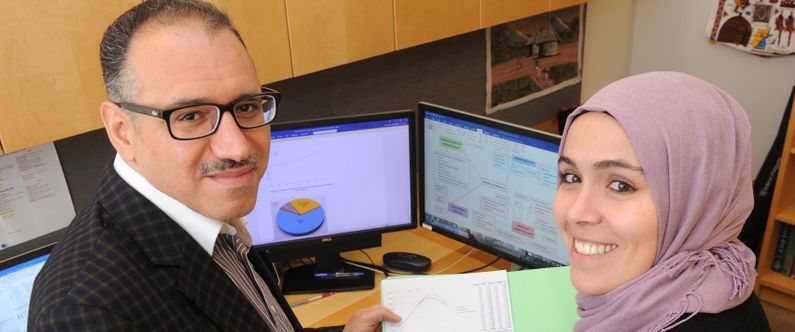WCM-Q study: At least one in four Qataris will have diabetes by 2050
 WCM-Q's Professor Laith Abu-Raddad, principal investigator of the study, and researcher Susanne Awad, first author, used mathematical modeling techniques to forecast diabetes burden in the Qatari population up to 2050.
WCM-Q's Professor Laith Abu-Raddad, principal investigator of the study, and researcher Susanne Awad, first author, used mathematical modeling techniques to forecast diabetes burden in the Qatari population up to 2050.
Researchers at Weill Cornell Medicine-Qatar (WCM-Q) predict that type 2 diabetes prevalence in Qatar will soar from 17 percent in 2012 to at least 24 percent by 2050.
Qatar is already one of the countries most affected by type 2 diabetes worldwide and, according to findings published in Diabetes Research and Clinical Practice, this epidemic is set to worsen in the next three decades, driven by the ageing of the population and high levels of obesity.
The WCM-Q study, ‘Forecasting the Burden of Type 2 Diabetes Mellitus in Qatar to 2050: A Novel Modeling Approach’, was conducted with funding from the Qatar National Research Fund, a Qatar Foundation member, through the National Priorities Research Program.
The study used sophisticated mathematical modeling techniques to forecast diabetes burden in the Qatari population up to 2050. Despite already being over twice the global average, with 17 percent of Qataris currently living with diabetes, it was projected that at least one in every four adult Qataris will have diabetes by 2050 (Figure 1).
The researchers also calculated the likely economic costs accompanying the rise in the prevalence of diabetes.
“Not only have we projected an alarming increase in the diabetes epidemic, but we also forecasted a high burden of diabetes on Qatar’s health expenditure,” said Susanne Awad, first author of the study and senior mathematical epidemiologist at the Infectious Disease Epidemiology Group at WCM-Q. “While diabetes is already consuming about 20 percent of Qatar’s national health expenditure, it will consume nearly one-third of the national health expenditure by 2050, according to our model.”
One of the main findings of the study is that most cases of diabetes are due to obesity. The fraction of Qataris who are obese stands currently at 41 percent, but was projected by the study to increase to 51 percent by 2050. The study also forecasts that, by 2050, 66 percent of diabetes cases will be caused by obesity (Figure 2).
Professor Laith Abu-Raddad, principal investigator of the study and professor of healthcare policy and research at WCM-Q, said: “Though there are several causes of Qatar’s diabetes epidemic such as direct genetic factors, low levels of physical activity, and smoking, the combined role of these factors was relatively minor compared to obesity. Obesity was by far the leading driver of the diabetes epidemic in Qatar.”
The study provided a framework for generating strategic information to inform diabetes public health policy, programming and resource allocation at the national level. The framework also offers a platform for extensions to assess the impact and cost-effectiveness of interventions against diabetes and its leading risk factors.
“It is a priority to focus on public health and lifestyle interventions to control, or even reverse the rising diabetes burden through individual- and population-based prevention approaches. These approaches remain to be tested to determine their feasibility and effectiveness in Qatar,” said Professor Abu-Raddad.
The research was only possible thanks to support from Qatar National Research Fund through grant NPRP 7-627-3-167.
Dr. Khaled Machaca, associate dean of research at WCM-Q, said: “WCM-Q, with strong support from the Qatar National Research Fund through the National Priorities Research Program, is committed to developing strategies to tackle the rise of obesity and diabetes in Qatar. This important study gives us a better understanding of the nature of the diabetes disease burden in Qatar and will therefore help us to more effectively target future interventions.”

